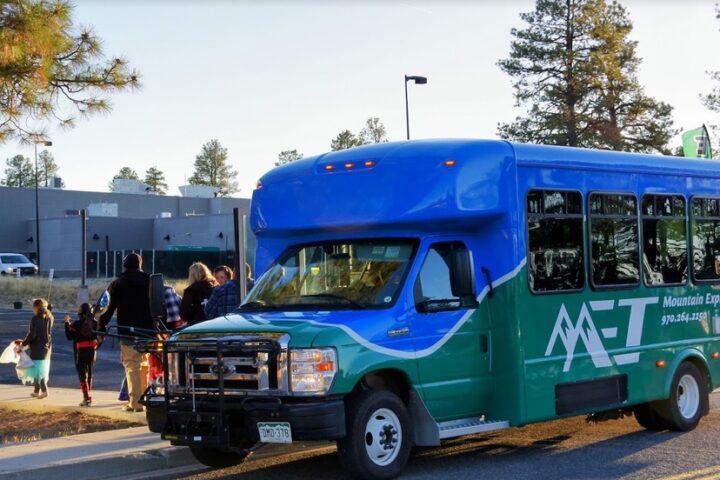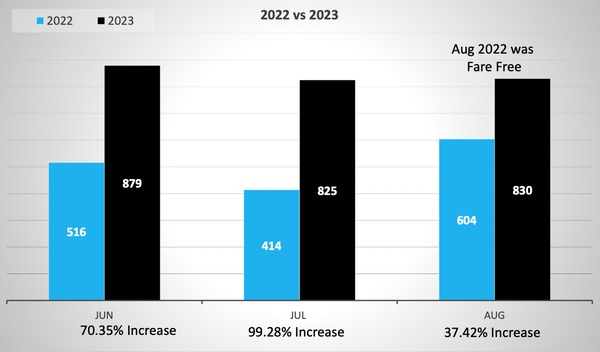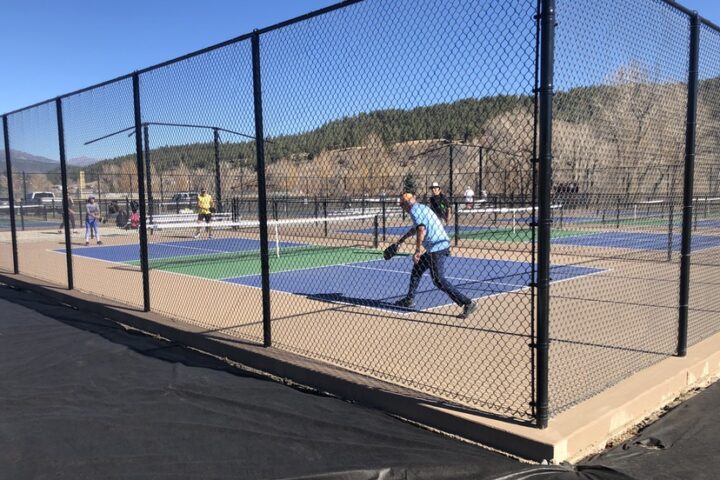I stopped by the pickleball courts on a recent Sunday, just before the lunch hour, thinking that I might find the eight new outdoor courts at Yamaguchi South full of pickleball players… enjoying the sunny weekend weather… but found only three courts in use.
Two games of ‘doubles’ and one game of ‘singles’. Maybe I had picked the wrong time of day? I had heard that pickleball has become almost unbelievably popular in Pagosa Springs.
Pickleball was on my mind, because I knew that the Pagosa Springs Town Council, the Archuleta Board of County Commissioners, and the Pagosa Springs Area Tourism Board helped fund these new courts, to the tune of $350,000, with another $100,000 contributed by the Pagosa Pickleball Club.
The Town and Tourism Board seem to have plenty of money for recreational activities. I didn’t see any funding in the proposed 2024 budgets, for either the Town or the Tourism Board, for the Mountain Express Transit system.
Pickleball is a fine game, and especially popular among retirees in the U.S. and in Pagosa Springs. Not too strenuous, and a great way to socialize. It’s more popular than riding the bus, I would guess.
Governments have to set priorities, for how they spend our money. What services are provided. Which businesses and groups are subsidized. Which activities require a fee. Who gets to ride free.

Archuleta County knew Mountain Express Transit was going to be challenging, financially, back in 2002 when it first started running a fixed route through Pagosa Springs. Very few public transit systems collect enough in fares to fund the system’s cost, and the MET is particularly challenged.
Challenged by a suburban development pattern, mainly.
For a sense of what I mean, we could look at an ‘urban’ development pattern. Take, for example, the island of Manhattan. Manhattan is home to 1.7 million people, and it has about 500 miles of city streets. That comes to about 3,400 people per mile of street. It’s a simple matter for a bus to pick up and transport hundreds of people during an hour-long route.
Archuleta County is home to about 14,000 people, and it has about 320 miles of residential roads (not including the state highways). That comes to about 43 people per mile of road. But very few of those 43 people are looking for transit service. Because of our sparsely populated suburban development pattern, it’s impractical to live in Pagosa Springs without a car.
Manhattan was designed for people, and public transit. The Pagosa Springs community was designed for cars. (And trucks.)
There’s no practical way for the MET to design a bus route that serves all 320 miles of county roads. In order to design a route that can be driven in one hour — so another trip can begin over the same route — the MET hits only a few residential neighborhoods and travels mainly through commercial areas. Except in the historical downtown area, most people in Pagosa live miles away from a regular bus stop.
Last summer, the month with the highest ridership on the fixed routes was June, with 810 free rides provided under the state-funded ‘Zero Fare for Better Air’ program. The free rides ended on September 1, and the MET provided only 498 rides that month — an average of about 2 riders per one-hour route — collecting $1 or $2 dollars per rider, depending on how far they were going. Except that
Recently, the MET has been doing runs to Aspen Springs and to Durango. It also offers a door-to-door ‘Paratransit’ service — door-to-door service within a certain driving distance of the central core — but those trips require reservations, made 24-hours in advance.
A couple of interesting facts from the American Public Transportation Association. Traveling by public transportation is 10 times safer per mile than traveling by automobile. A person can reduce their chance of being in an accident by more than 90%, simply by taking public transit as opposed to commuting by car. A household can save more than $13,000 by taking public transportation and living with one less car.
But those stats are based on public transportation trends in big cities, and do not necessarily apply to a rural community like Pagosa Springs.
I don’t know if the MET tracks the demographics of its clientele. Typically, the people who access public transit are low-income — unable to afford a car, for example — or seniors or disabled folks unable to drive. In big cities, public transit is popular with younger populations struggling economically.
Some cities have been experimenting with alternative ways to serve these populations, and have found that subsidizing rides provided by private taxis or ride-hailing services can be an economical alternative to a government-run system. In 2016, the Massachusetts Bay Transportation Authority began a pilot program which has subsidized paratransit passengers on Uber, Lyft, and Curb. This retained the ability to book by phone, lowered the fare for riders, eliminated the need to book the trip a day in advance, eliminated shared trips, reduced in-transit time, and reduced the pickup wait time from 30 minutes to as low as 5 minutes in the urban core.
Pilot participants on average substantially increased the number of trips they took, but still at a lower overall cost to the agency.
Availability of wheelchair-accessible vehicles remained an occasional problem, but these were only needed by about 20% of paratransit riders.
According to the stats presented to the BOCC last month by MET director Kevin Bruce, the ridership during the ‘Zero Fare for Better Air’ program — with everyone riding for free — averaged about 850 rides per month, system-wide, during the busy summer tourist season. Ridership dropped significantly in September, however, after the ‘Zero Fare’ program ended.

Currently, seniors over the age of 60 ride for free on MET. And now, as of November 1, veterans also ride for free. With those two groups riding free, MET director Kevin Bruce believes the MET will collect about $7,000 in fares during 2024.
The projected budget for the MET, for 2024, is $434,000. For a subsidy of $7,000… could everyone ride free? Would that be a good thing?
It seems to me, as a casual observer, that Pagosa Springs has the opportunity to move in a couple of different directions. We can help people who really need help, and create a diverse community.
Or we can subsidize wealthy investors and retirees who need $450,000 pickleball courts, and gentrify the community into a place where only millionaires can afford to live.

We have a choice.
We can tell our leaders, we want a diverse community.

